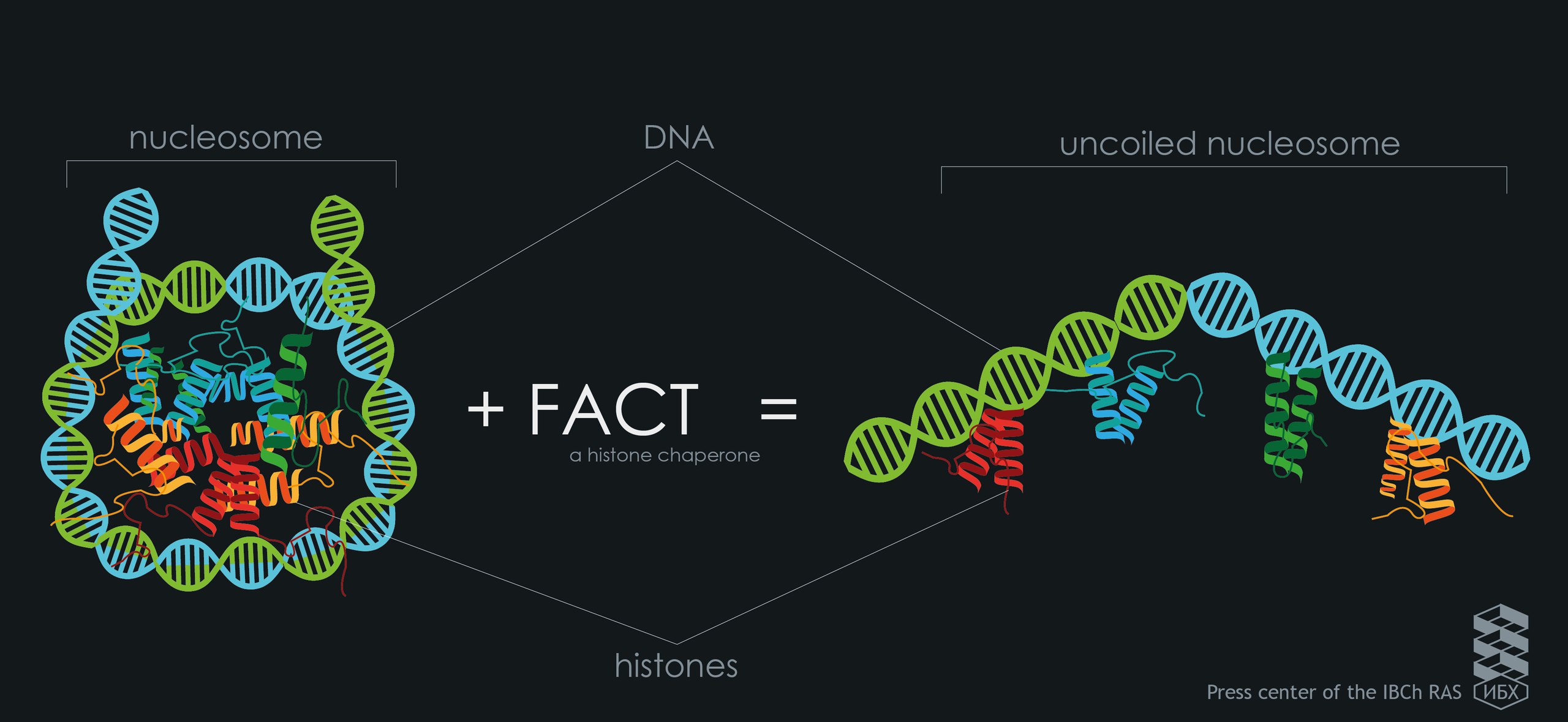Press-room / news / Science news /
Protein Complex FACT able to unwind Nucleosomes without expending Energy
A group of researchers from the Institute of Bioorganic Chemistry of the RAS and Moscow State University, in collaboration with the University of Utah, has for the first time successfully made use of the FRET-microscopy method to demonstrate the ability of nucleosomes to reversibly unwind under the action of FAST without expending any energy. The data obtained will in the future help scientists understand what role this protein complex plays in actively dividing cells in tumor tissues. The results of this breakthrough research were published in the Nature Structural & Molecular Biology journal.
“This research work can be viewed as a perfect example of the successful collaboration between the two research groups,” remarks Kseniya Kudryashova, PhD, a researcher with the Bioengineering Department of the Institute of Bioorganic Chemistry of the Russian Academy of Sciences. “The first group is headed by Vasily M. Studitsky, a senior researcher with a wealth of experience working with nucleosomes, Head of the Laboratory of Regulation of Transcription and Replication of the Lomonosov Moscow State University. The second research team conducted a research under the supervision of Alexei V. Feofanov, a specialist in Microscopic Techniques in biology, Head of the Laboratory of Optical Microscopy and Spectroscopy of Biomolecules of the Shemyakin&Ovchinnikov Institute of Bioorganic Chemistry of the Russian Academy of Sciences.”
As is currently known, the DNA molecule is compactly wound up in cell nuclei. Correctly placed genomes provide special proteins that, together with the DNA, form a certain structure called chromatin. The nucleosome acts as the unit of compaction for the chromatin. Nucleosomes are often compared to a thread spool, in which the DNA ‘thread’ is wound on a barrel of histone proteins – the ‘spool’. The dense packing of chromatin in the nucleus is violated during transcription, when there is an active reading of genetic information from DNA. The FACT Conservative Protein, which has become the object of attention of many scientists, facilitates the transcription of chromatin protein. Although the interaction of FACT with the nucleosome has been demonstrated in earlier works, this is the first time that scientists have been able to find out the important details of the process.

One of the possible models of unwinding FACT nucleosome protein complex. Author: Snezana Mazhekenova.
The researchers studied the interaction of the FACT protein factor with the spFRET-microscopy nucleosome method.
“As a result of the productive work that was started back in 2010, scientists were able to develop the spFRET method from scratch and apply it specifically in the study of nucleosomes,” explains Kseniya Kudryashova. “Based on this method, scientists are able to work with the microscopy of single molecules. Fluorescent markers are introduced in adjacent loops of the nucleosomal DNA. One of the markers serves as an energy donor, while the other as the acceptor. The donor can be excited using a laser of a specific wavelength. If the donor is located close to the acceptor, energy is transferred to the acceptor. The closer the position of the marker, the brighter the signal from the acceptor. In this way, it is possible to monitor the distance between adjacent DNA loops and assess how much the nucleosome is compactly folded. This is a unique development for Russia that allows us to study structural changes in the nucleosome complexes with a resolution of a few nanometers, with the information collected from each molecule individually.”
Using this method, scientists for the first time demonstrated the ability of the nucleosome to unwind reversibly under the action of FACT in vitro (test tube) without expending energy, which is quite unusual. This is given that the ATP-dependent remodeling complexes for chromatin reorganization expend a lot of energy.
During the formation of the FACT- nucleosome complex, DNA strands are practically completely straightened, but remain bound to the histone proteins. If FACT is removed from the complex, then everything goes back to square one: the DNA nucleosome winds itself on the base of the histones. Thus, FACT is indeed a rare example of an ATP-independent (with non-natural sources of energy) chromatin-remodeling complex.
According to Mary Valieva, the foremost author of the article from Moscow State University, in a cell, the ability of FACT to reversibly change its chromatin structure may help activate certain genes through the reorganization of DNA components. However, nothing more specific can be said about similar other processes occurring inside cells, as the question is still poorly understood. The author notes that the study of this protein complex is important not only scientifically, but also from a medical point of view. This is because tumor tissues contain large quantities of FACT. That is why scientists are now faced with the question: “What role does this protein complex play in actively dividing cells?”
december 7, 2016

